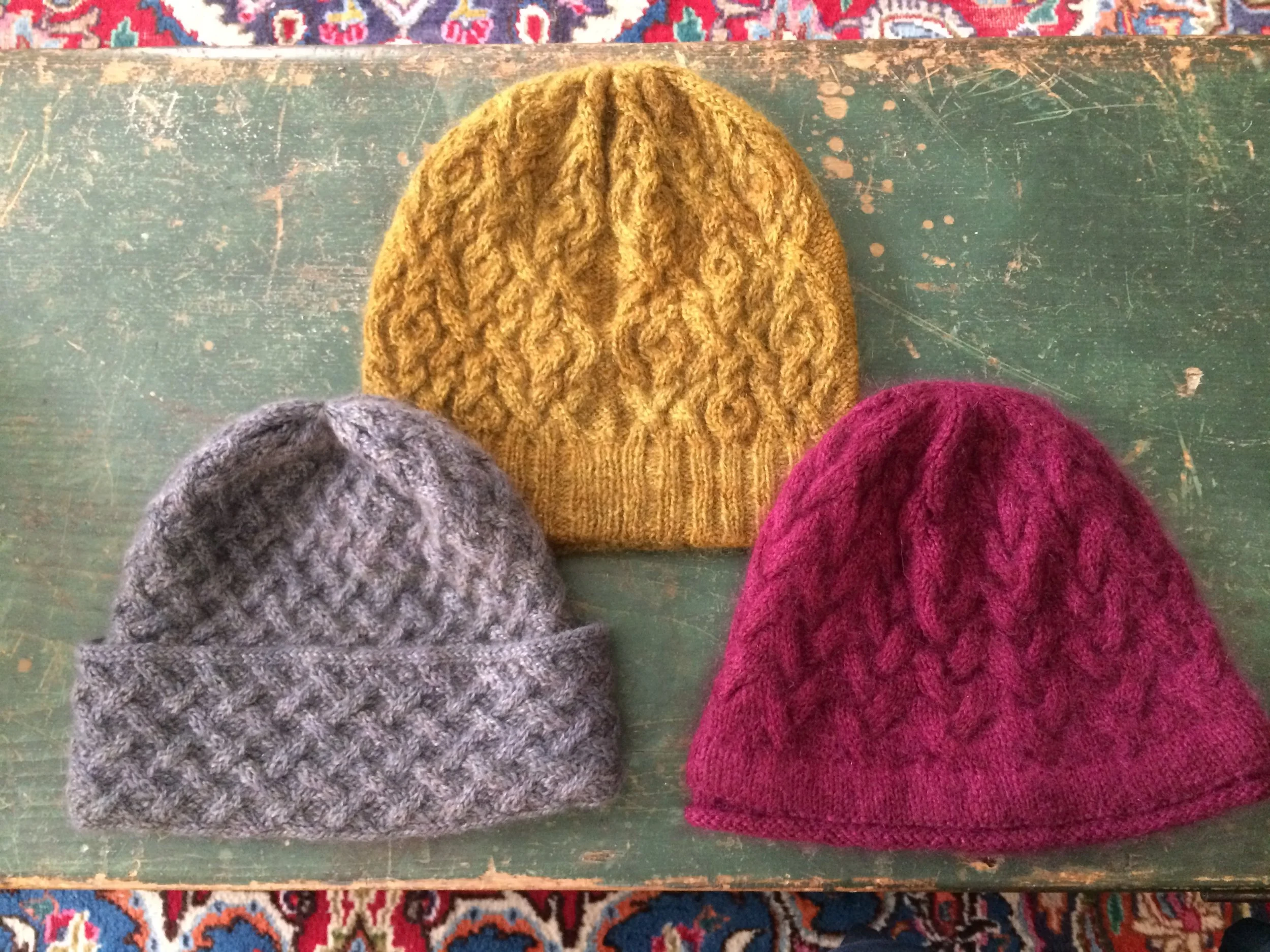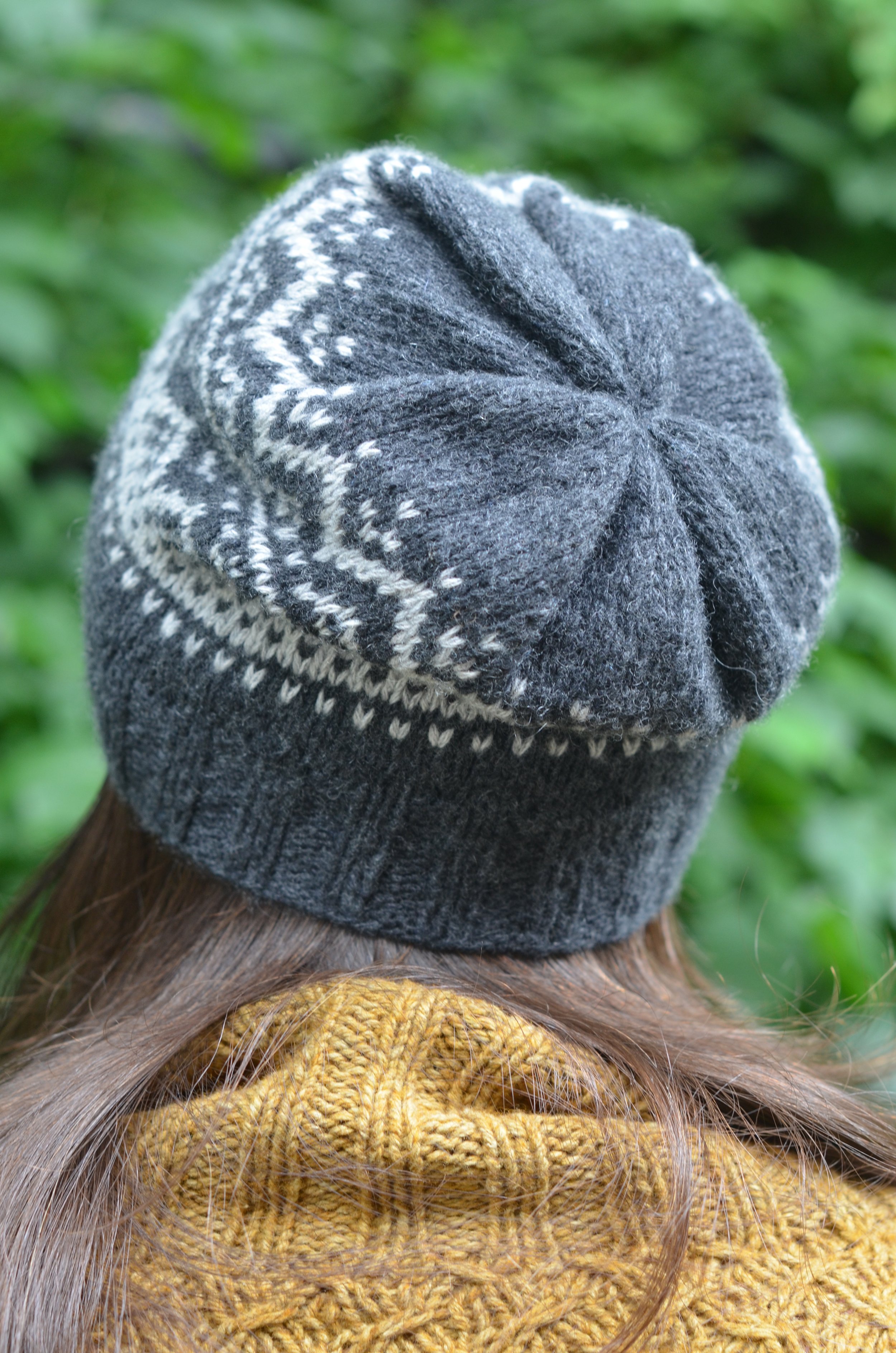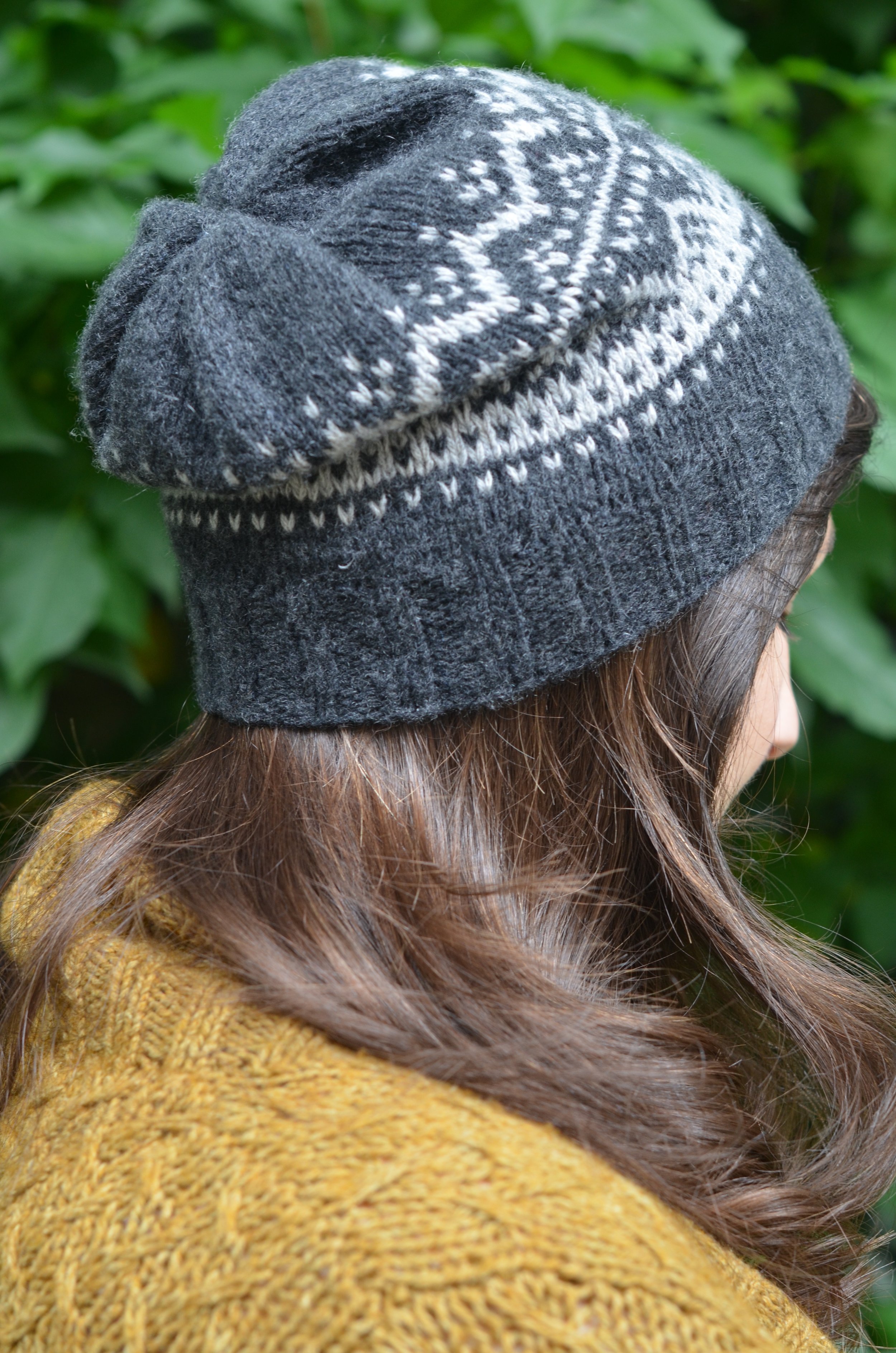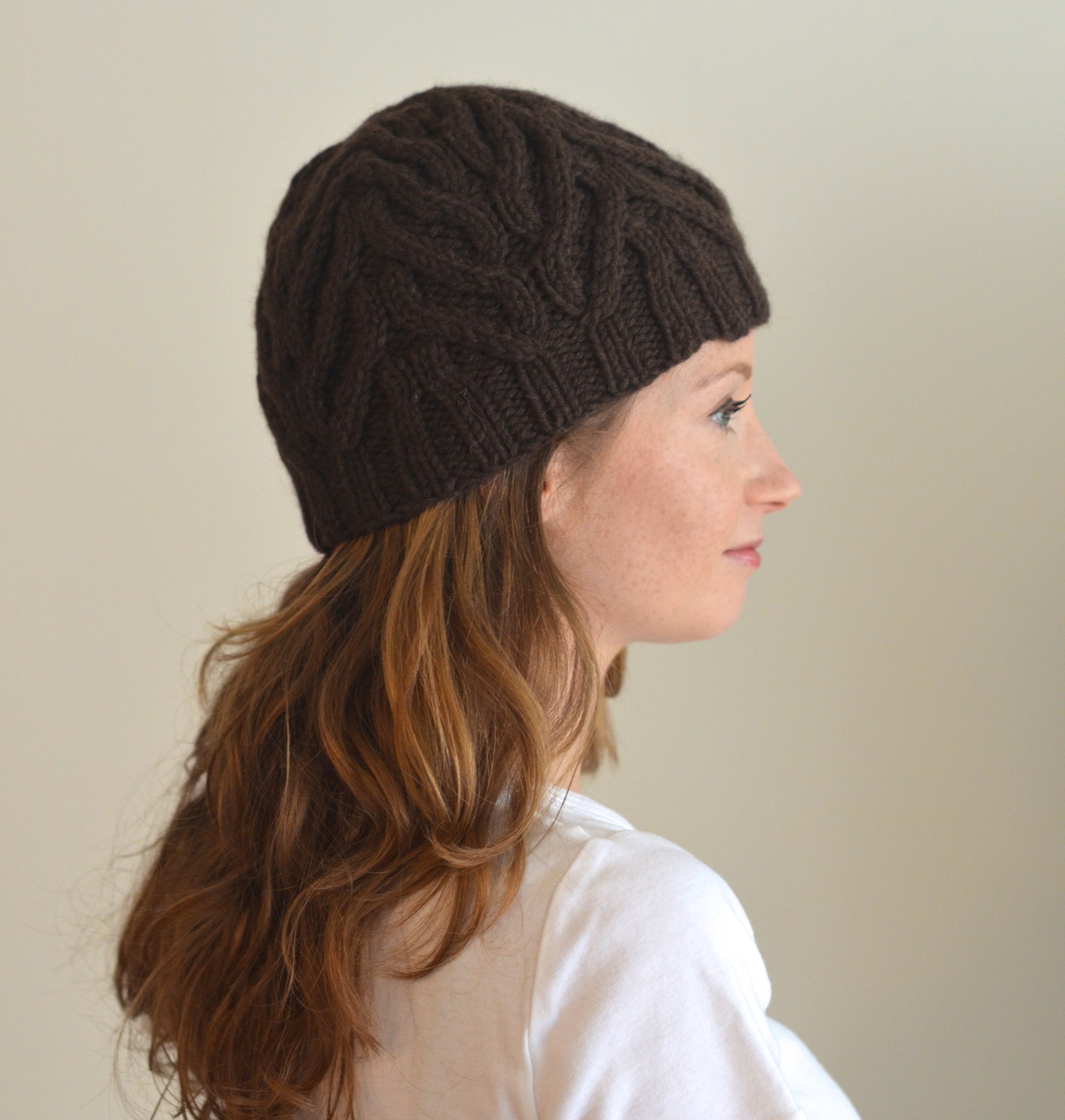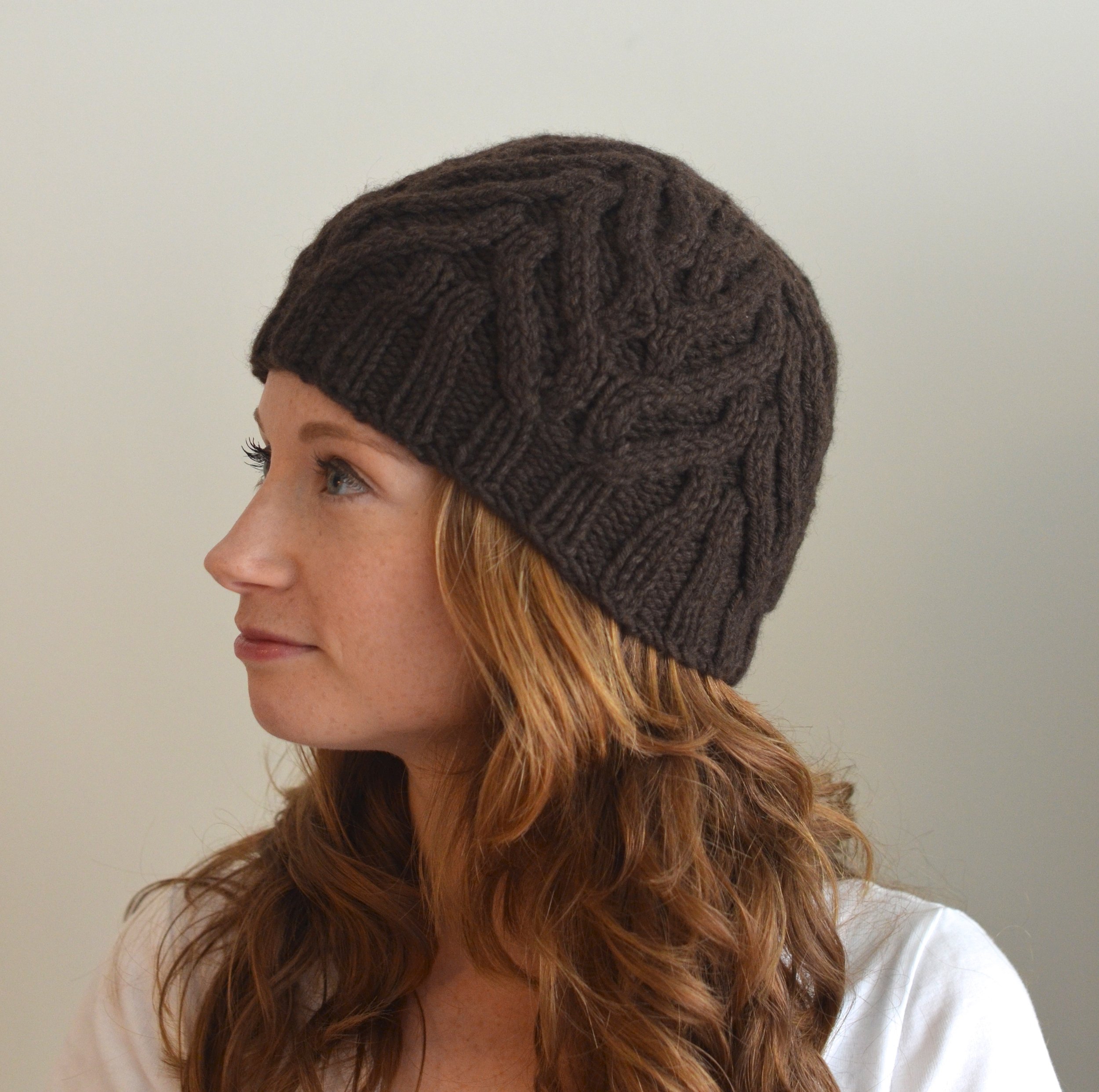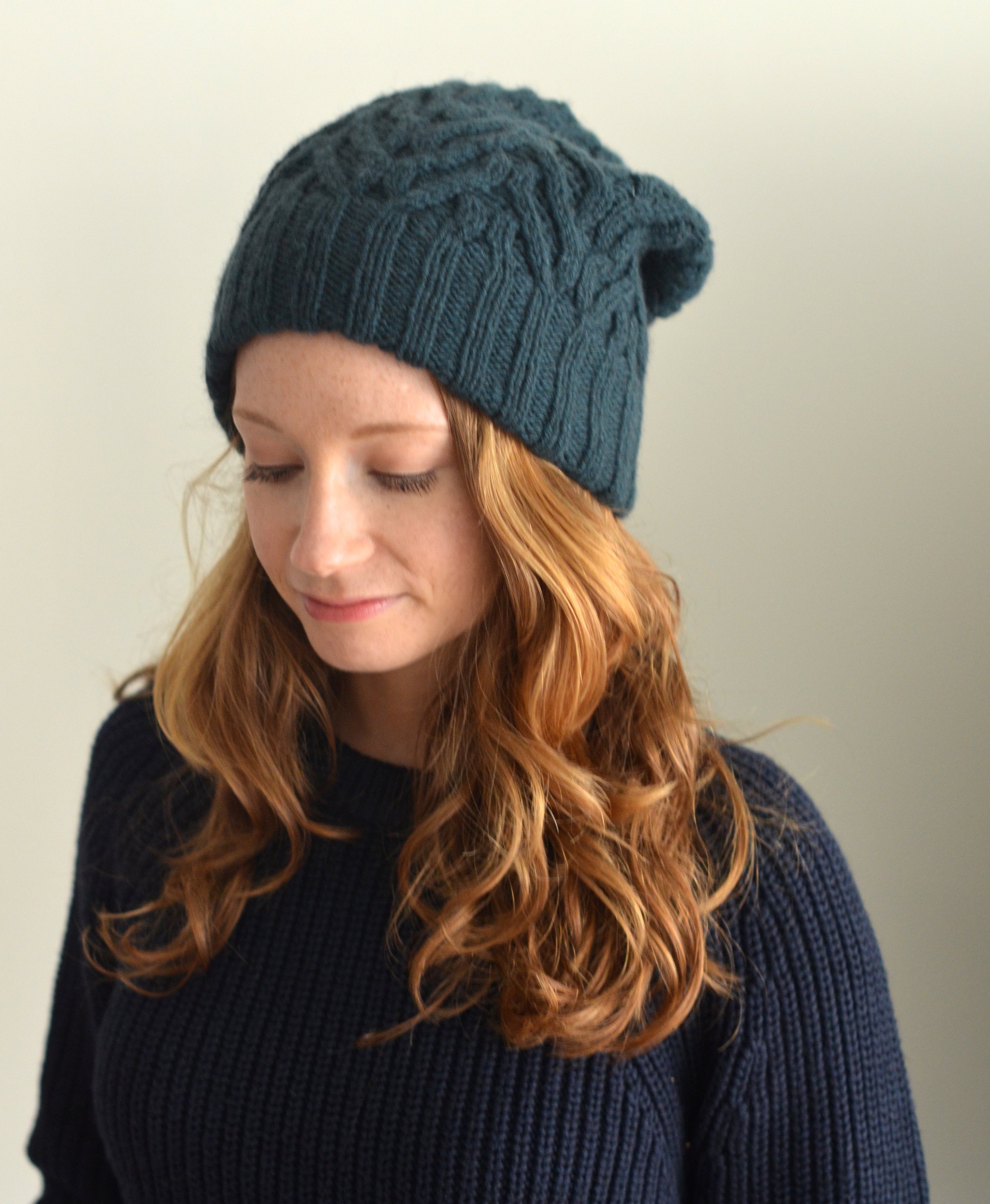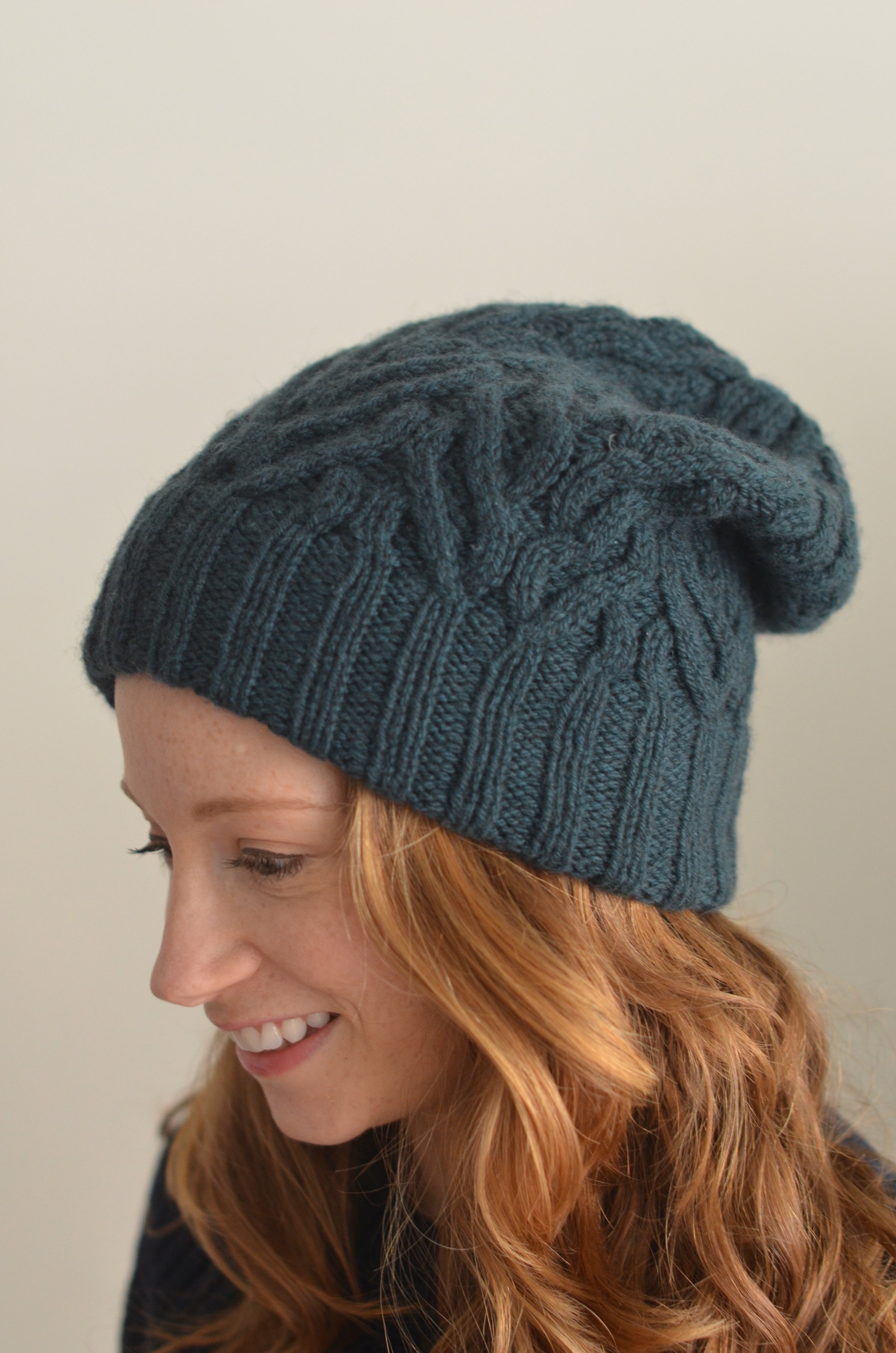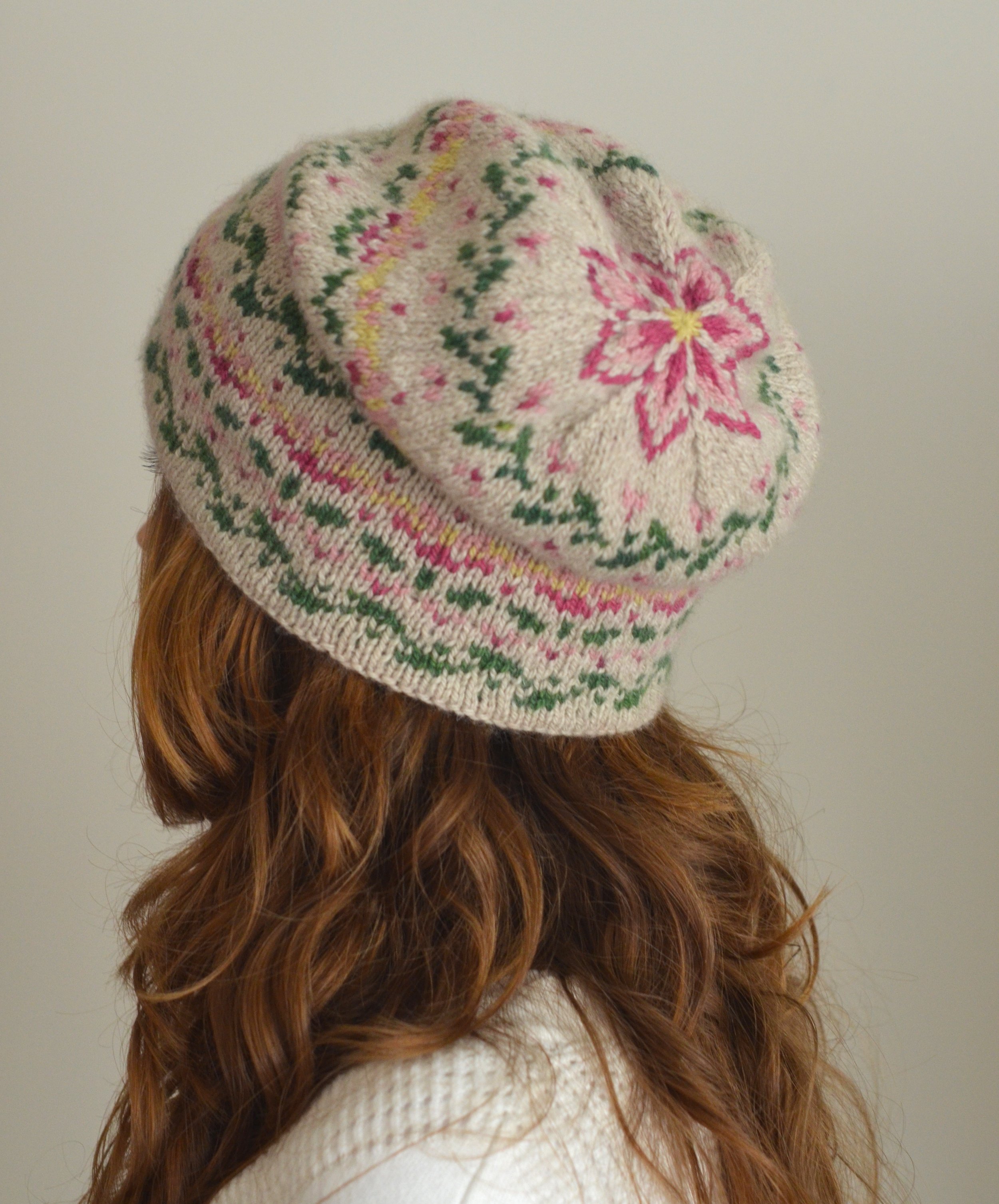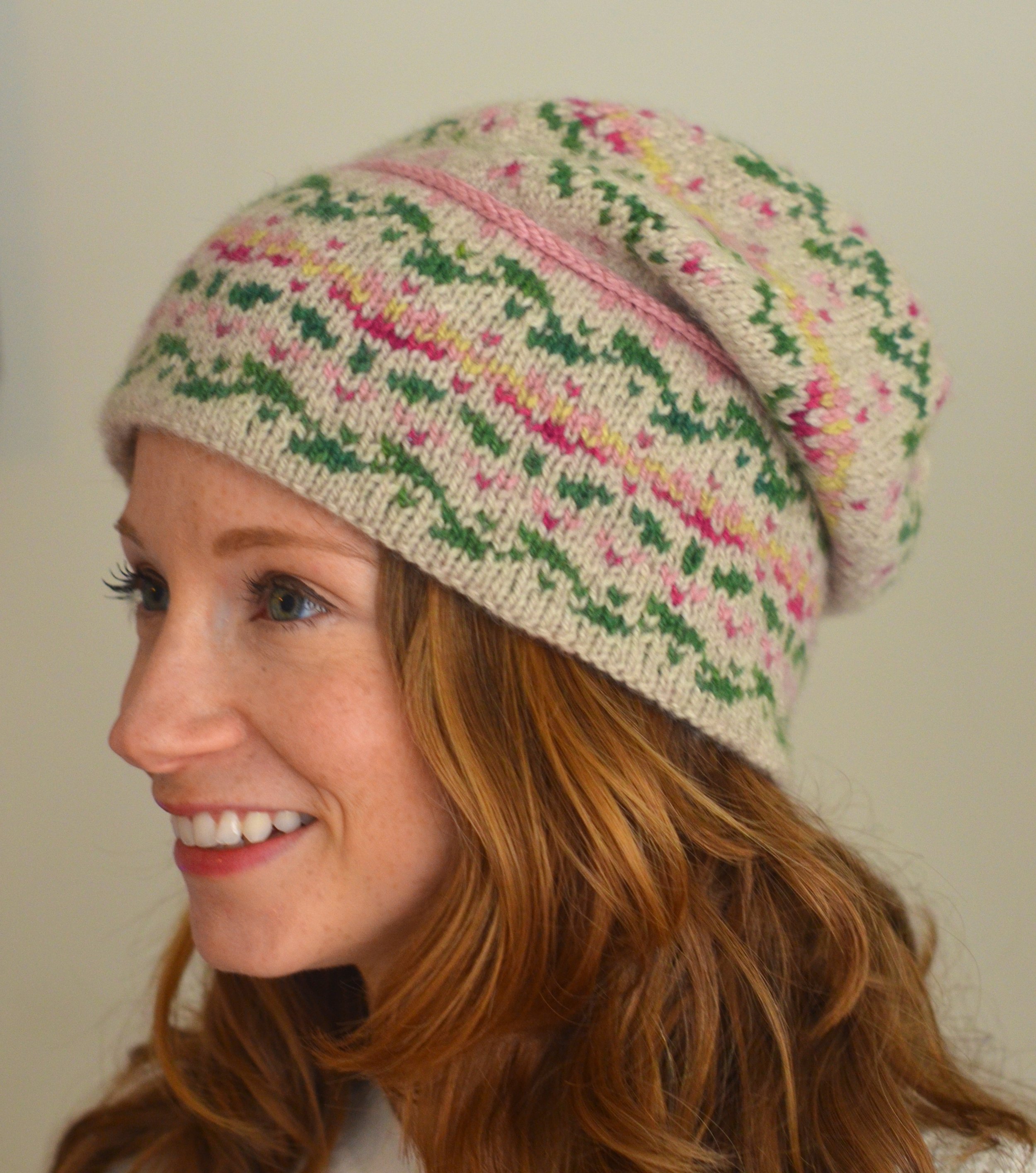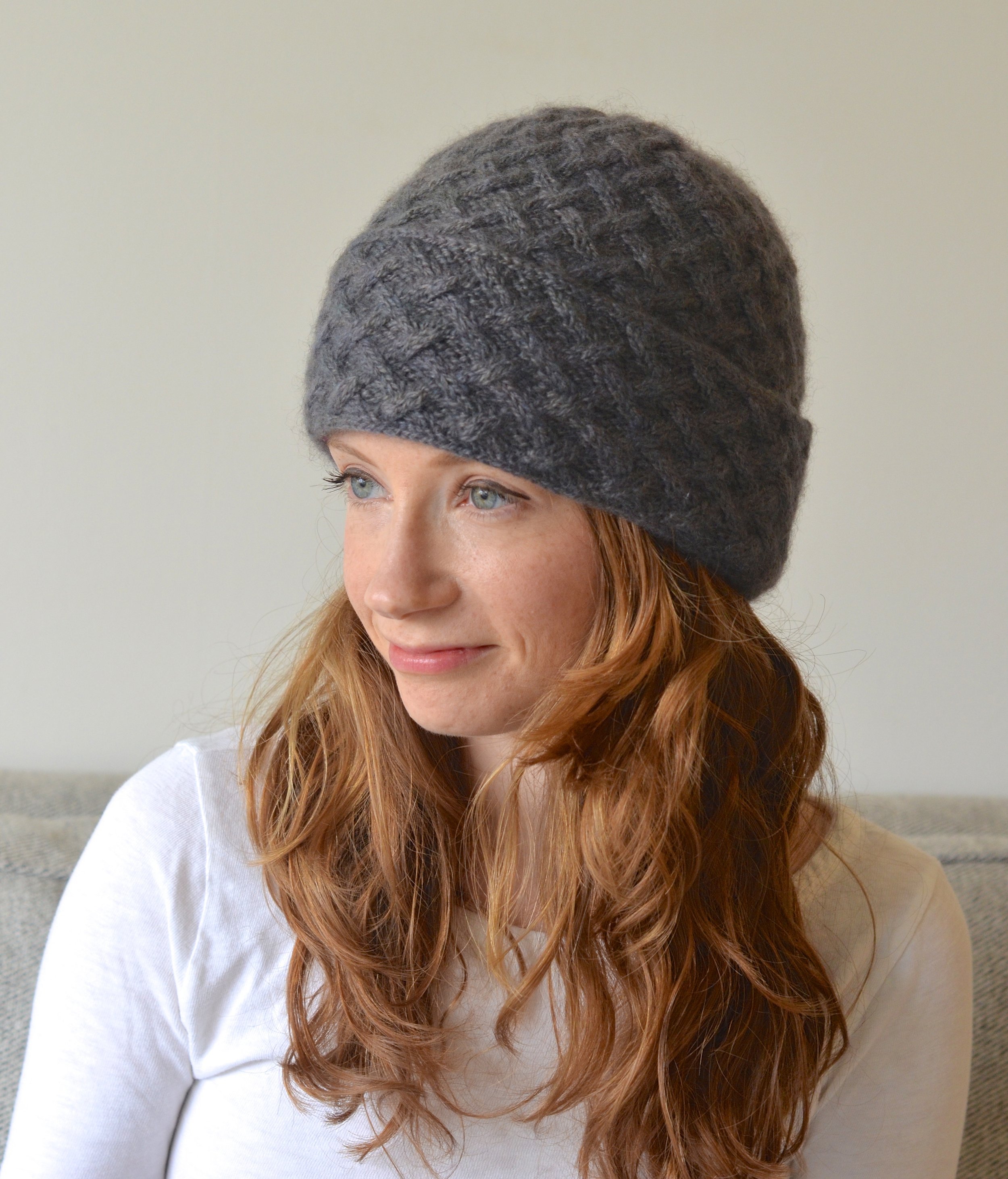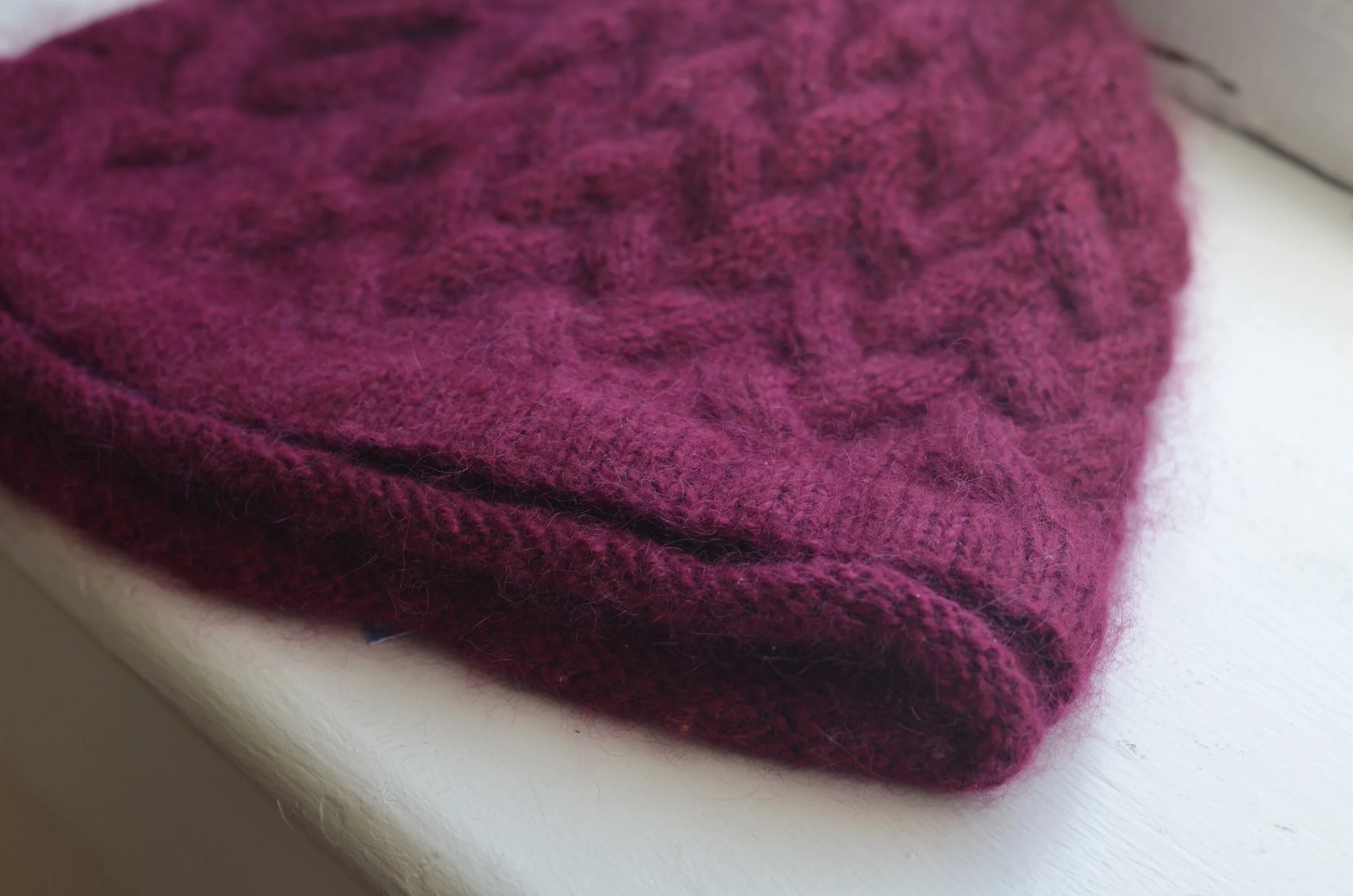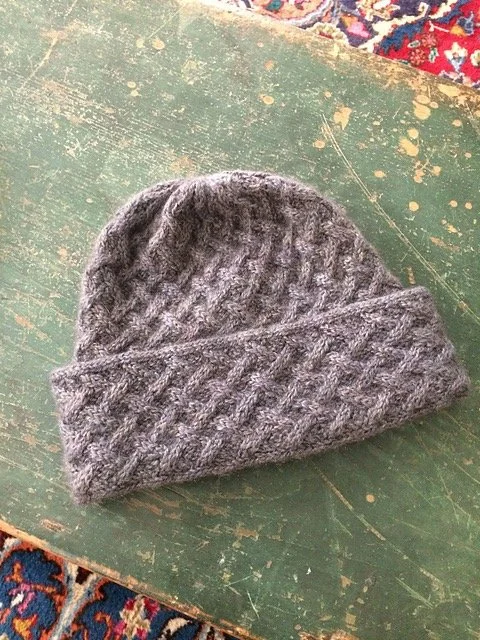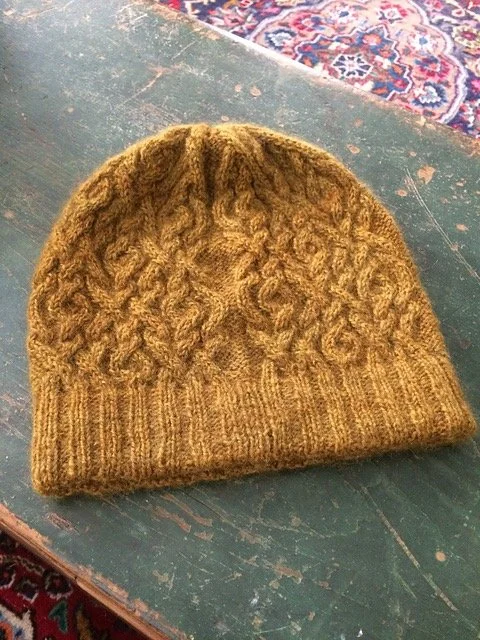Crown Jewels
I know that this is usually a fairly sweater-centric place, but the last few months I finally took a break from making one sweater after the next and allowed myself the time to experiment with hats. I thought I was just going to dip my toes in and bring a few ideas I've had to life, but that never seems to be the way it goes with me. I started one hat and suddenly there was a flurry of hat ideas and I had to get them all out into the world. And for some reason I've settled into working in batches of three. First I did three for Interweave publications, two of which have just come out in Knitscene's new Accents Collection:
The Midnight Cap in Harrisville Designs Nightshades. This yarn is really unlike anything else I've worked with before. It's a woolen-spun blend of American Cormo and other (unspecified) wool in a palette of near-black colors. The color shown here (called VCR), is black with a haze of dark green. The yarn is both soft and crisp at the same time. I absolutely loved working cables and rib with it; I do so much work with lanky fibers (which I love) but it was just so lovely to work with good old dependable wool that does exactly what you want it to––hold its shape, make a dense, springy rib, sculpt a beautiful cable. Nightshades did all of that and more and since each skein is a generous 250 yards I was able to make this doubled-brimmed, densely cabled hat with just one skein.
From the same collection, here’s the Snowy Peaks Hat in Jones & Vandermeer’s Ethos yarn, a blend of 50% cashmere and 50% recycled cashmere. This pattern conjured itself up when J & V generously gave me some of this yarn to swatch with and around the same time I was in need of a teaching pattern for some upcoming colorwork classes. It was kismet. The pattern is intended to be a placid introduction to stranded colorwork; easily memorizable repeats with no long floats to worry about. This yarn is extremely light and has lovely drape. It’s rather thin looking in the skein but puffs up and blooms beautifully once it’s had a bath. The extreme lightness of the fabric it creates allowed me to pull off a somewhat unusual combination of decreases and gathers in the crown which gives it an elegant poof. Even though the fabric is very light, it is exceptionally warm for its weight so it’s a wonderful hat to keep in a coat pocket and have at the ready to pull out when the weather turns chilly.
Little Burr in mYak Medium
and Posey in mYak’s Natural Dyed Tibetan Cashmere. I really went wild with this one. Ordinarily I feel that design is largely about restraint for me but this time I just made something pretty and then thought about ways to make it even prettier. I started it as a whim in a March snowstorm when one of my classes was cancelled and I suddenly had a few hours to do just what I liked. I had to put it down for several months to finish many other projects so I finally finished that flowery crown on a burning hot July 4th afternoon. It was a delight painting in the motifs with the plant-dyed colors, though I’m tempted to try it again in something like Jamieson’s and really play with the palette. But I’ll probably have to wait for another snowstorm to try that.
My last batch of three were released a couple of weeks ago at the Northeast Handspinners Gathering.
Dolcetto
These ones I affectionately refer to as my Crown Jewels. There's something about the extraordinary depth of color and the brilliancy of the fiber that makes them glitter like gem stones. This little collection was a new collaboration for me, with PortFiber of Portland, Maine. The PortFiber shop is a paradise for spinners, knitters, felters, dyers and weavers and it's run by one incredible fiber-loving person, Casey Ryder. Casey's newest venture has been to become the distributor for Cashmere People Yarns. This is a big undertaking for a one-woman business and I wanted to lend a hand in getting the word out about the yarn in the best way a designer can; by showing what you can do with it. Cashmere People yarns are made in Afghanistan and Tajikistan by women's co-operatives and they are hand-spun and hand-dyed from locally produced cashmere and cashgora fibers. Both of these fibers are stunning, but I chose to focus on the cashgora for my first designs, partly because it's a fiber that is so rarely seen commercially available, but largely because those luminous colors were calling to me.
The cashgora produced in the Pamir Mountains of eastern Tajikistan is the result of crossing Russian fiber goats with local cashmere-type goats. The micron count is slightly less fine than cashmere and the staple length is longer, which gives strength and durability. To me, the fiber combines the softness of cashmere with the sheen and strength of mohair. One of the reasons the color palette is so striking is because some of the colors are dyed over the natural brown goat fiber, rather than over the natural white. It really shows you what we're missing in the fiber world when almost everything is dyed over white. Over-dyeing on the brown fiber gives a rare warmth and depth to the color.
Each skein features a photo of the woman that spun it and a little bit of information about them. There are also more extensive bios on the Cashmere People website.
What I like most about this yarn is how alive it is. The fiber itself has a spring and vitality to it and that, combined with the inherent energy of hand-spun yarn, makes for a truly unique knitting experience. Before I had knit with hand-spun yarn, I quite honestly did not understand what people were talking about when they referred to its "energy." But the first time my Mum and I knit up some handspun swatches I became fully evangelized. It's really as if you can tell that your yarn was made by human hands, rather than machines. The first hat I knit in this collection was Dolcetto in the color Borscht spun by Mohira (pictured above) and I've never had such a connection to a skein of yarn. I really felt as if Mohira had made it just for me and I was quite literally enjoying every stitch.. And even in the finished hat there is something in the fabric that is quite unlike commercially spun yarn, a combination of extreme softness and delicacy combined with strength and elasticity.A bit about the design concept for this collection. I wanted to create one-skein projects that would introduce knitters to the yarn and the mission of the company. This yarn is perfectly suited to lace and a collection of one-skein cowls would have been an equally good use of the yarn, but something about the colors and the warmth of the fiber just made me crave to have it on my head. Plus, you guessed it, using the yarn for hats presented a design challenge, since goat fibers lack the elasticity of wool and have a strong tendency to drape and spread out. And as you may have gathered by now, I enjoy a design challenge. Or rather, I am incapable of making things easier on myself. Or a bit of both! So for each hat I tried a different construction method to add structure (to the brim area especially) in order to guarantee a hat that would keep its shape over time.
Dolcetto features a triple brim construction. It's really just a regular hem with an added rolled hem beneath it. The traditional hem adds the necessary structure and the rolled hem creates an extra layer of warmth as well as a soft frame for the face. I sometimes find close-fitting hemmed hats a bit severe looking on me, so I liked the idea of the face-framing extra layer.
For Brume, you knit the hat from a provisional cast on to the crown in a cabled texture which makes it very dense and warm. You then finish the hat bottom with an i-cord bind off. Then a band is picked up from that edge and knit in the same pattern as the rest of the hat and ends in the same i-cord bind off for a matching finish. Getting the ratio of stitches and needle size right at each stage of the process took some figuring, not to mention shaping the crown in pattern, but the result is a densely knit hat in an enduring stitch pattern that provides extra protection for your ears and is designed to keep its shape over time.
Lamplight was percolating the longest in my mind. I saw this color and immediately connected it with this cable but my original idea for the shape simply wouldn't work in such a drapey yarn so I started planning a long slouchy cap that would allow you to see as much of the cabled scrollwork as possible. For the band I wanted to use rib and have the pattern flow out of it (always a challenge but a rewarding process once you've gotten it figured out). But I decided to use stockinette inside the band partly because it feels so delightfully soft on the forehead and partly to lend more structure once again. It took quite a bit of experimentation (done under auspicious conditions in my hotel room during Meg Swansen's Knitting Camp last summer) but it came together in the end and I simply love the result. This color (Tabac) seems to cast a spell over all who see it and for very good reason; it has a mercurial quality that makes it appear different in every change of light and keeps your eye drawn to it, like a bright spot in a dark painting.
Now that I'm fully acquainted with the cashgora yarn I have plans for more hats and cowls and maybe even a glorious sweater, but I'm also looking forward to trying the Cashmere People cashmere yarn as well, as it too seems to have very unique properties that I'm anxious to uncover in my next bout of fiber sleuthing. It really is an interesting process, getting to know a yarn and deciding what to do with it, learning to listen to what it wants to be or compelling it to be what you want it to be. In this case I feel that the cashgora and I struck a bargain that keeps us both happy. The yarn can bloom and shimmer exactly as it wants to and my unobtrusive band structures keep everything tidy and in its place.I'll be doing a trunk show displaying these samples and the entire gorgeous palette of cashgora colors at Annie & Company on the Upper East Side of Manhattan tomorrow night so if you happen to be in New York City here are the details:
Wednesday, December 12th from 5:00-8:30 pm
1763 2nd Avenue, SW corner of 92nd St. & 2nd Ave.
This truly is a yarn that you need to see and feel in person and I'll be sure to have a piece of knitting on the needles so that you can even try knitting with it if you're curious. When it comes to yarn, feeling is believing.
